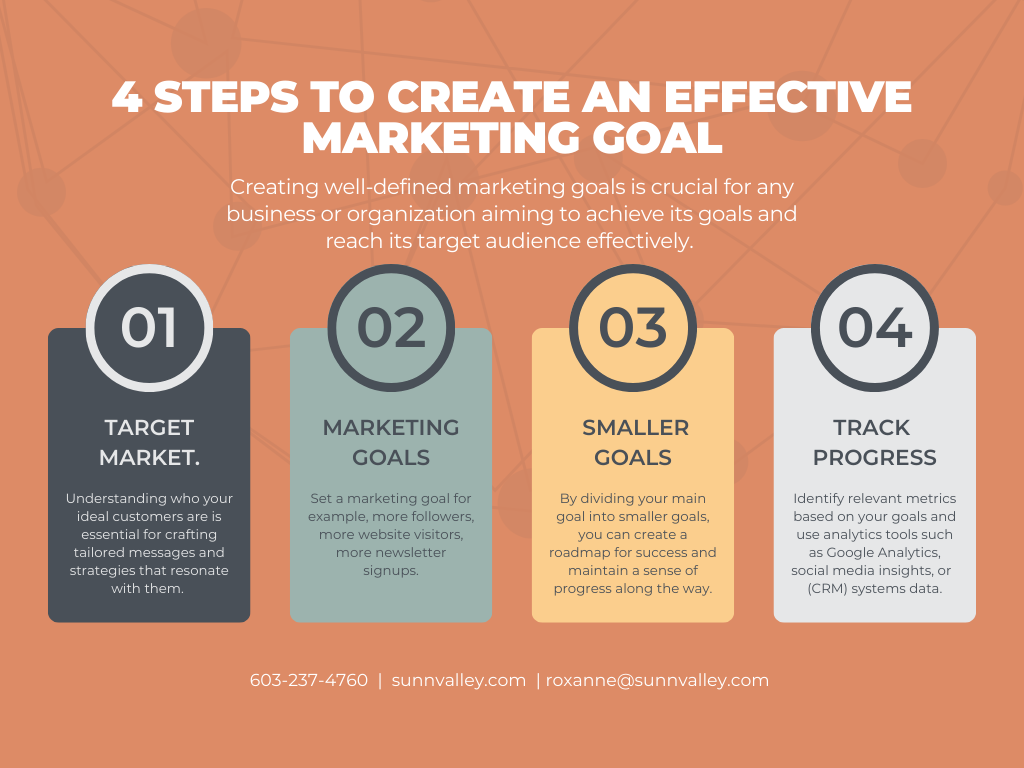Creating an effective marketing goal is crucial for any business or organization aiming to achieve its goals and reach its target audience effectively. However, developing a marketing goal can be a daunting task if you’re unsure where to start. In this blog post, we will explore four essential steps to help you create a powerful marketing goal that drives results. From identifying your target audience to tracking your progress, these steps will provide you with a solid framework for success.

Step 1: Identify your target audience
One of the first steps in creating an effective marketing goal is to identify your target audience. Understanding who your ideal customers are is essential for crafting tailored messages and strategies that resonate with them. Start by conducting market research and analyzing customer data to gain insights into your target audience’s demographics, behaviors, interests, and pain points. This information will allow you to create buyer personas, and fictional representations of your ideal customers, which serve as valuable reference points throughout your marketing planning process.
By clearly defining your target audience, you can develop marketing goals and tactics that specifically address their needs and preferences. It enables you to create personalized and compelling messages that will capture their attention and drive engagement.
Step 2: Set a measurable goal
Once you have identified your target audience, it’s time to set a specific and measurable and effective marketing goal. Vague goals like “increase brand awareness” or “gain more customers” provide little direction and make it challenging to track progress. Instead, focus on setting goals that are tangible, quantifiable, and time-bound.
For example, if your goal is to increase website visits, a specific and measurable goal could be to increase website traffic by 10% in the next month. Other goals could include generating a certain number of leads, boosting sales revenue by a specific percentage, or improving conversion rates on your e-commerce platform. Clearly defined goals allow you to track your progress, evaluate the effectiveness of your strategies, and make data-driven decisions.
Step 3: Break it down into smaller goals
Large goals can often feel overwhelming, which is why it’s essential to break them down into smaller, more manageable objectives. By dividing your main goal into smaller goals, you can create a roadmap for success and maintain a sense of progress along the way.
Continuing with the example of increasing website visits, you can break it down into smaller goals such as enhancing search engine optimization (SEO), launching a content marketing campaign, implementing social media advertising, or improving website load speed. These smaller goals enable you to focus on specific areas of your marketing strategy, allowing for targeted efforts and more achievable milestones.
Step 4: Track your progress
Tracking your progress is a critical component of any marketing goal. Regularly monitoring and analyzing key performance indicators (KPIs) helps you evaluate the effectiveness of your marketing activities and make necessary adjustments.
Identify relevant metrics based on your goals and use analytics tools such as Google Analytics, social media insights, or customer relationship management (CRM) systems to gather data. Monitor metrics such as website traffic, conversion rates, email open rates, social media engagement, or customer acquisition costs. These insights will provide valuable feedback on your marketing efforts and help you make informed decisions about refining your strategies.
Remember that marketing goals are not set in stone. As you track your progress and analyze results, be open to adapting your strategy based on the insights gained. The marketing landscape is constantly evolving, and staying flexible allows you to seize new opportunities and address emerging challenges effectively.
Structured Approach
Crafting an effective marketing goals requires careful consideration and a structured approach.
By following these four steps—identifying your target audience, setting measurable goals, breaking them down into smaller objectives, and tracking your progress—you can create a comprehensive marketing goals that drive results. Remember to regularly evaluate and adjust your strategies based on data and market trends, as marketing is an iterative process that requires continuous improvement. With a well-defined marketing goal, you’ll be equipped to connect with your target audience, achieve your goals, and propel your business forward.

